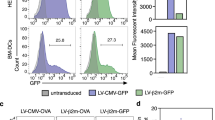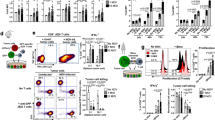Abstract
Targeting transgene expression specifically to antigen-presenting cells (APCs) has been put forward as a promising strategy to direct the immune system towards immunity. We developed the nanobody-display technology to restrict the tropism of lentiviral vectors (LVs) to APCs. However, we observed that immunization with APC-targeted LVs (DC2.1-LVs) did not evoke strong antigen-specific T-cell immunity when compared to immunization with broad tropism LVs (VSV.G-LVs). In this study, we report that VSV.G-LVs are more immunogenic than DC2.1-LVs because they transduce stromal cells, which has a role in activating antigen-specific T cells. Moreover, VSV.G-LVs trigger a pro-inflammatory innate immune response through transduction of APCs and stromal cells, while DC2.1-LVs trigger a type I interferon response with anti-viral capacity. These findings question the rationale of targeting LVs to APCs and argue for the development of VSV.G-LVs with an improved safety profile.
This is a preview of subscription content, access via your institution
Access options
Subscribe to this journal
Receive 6 print issues and online access
$259.00 per year
only $43.17 per issue
Buy this article
- Purchase on SpringerLink
- Instant access to full article PDF
Prices may be subject to local taxes which are calculated during checkout



Similar content being viewed by others
References
Wayteck L, Breckpot K, Demeester J, De Smedt SC, Raemdonck K . A personalized view on cancer immunotherapy. Cancer Lett 2013; 352: 113–125.
Breckpot K, Dullaers M, Bonehill A, van Meirvenne S, Heirman C, de Greef C et al. Lentivirally transduced dendritic cells as a tool for cancer immunotherapy. J Gene Med 2003; 5: 654–667.
Goyvaerts C, Breckpot K . Pros and cons of antigen-presenting cell targeted tumor vaccines. J Immunol Res 2015; 2015: 785634, 1–18.
Breckpot K, Aerts JL, Thielemans K . Lentiviral vectors for cancer immunotherapy: transforming infectious particles into therapeutics. Gene Therapy 2007; 14: 847–862.
Dyall J, Latouche JB, Schnell S, Sadelain M . Lentivirus-transduced human monocyte-derived dendritic cells efficiently stimulate antigen-specific cytotoxic T lymphocytes. Blood 2001; 97: 114–121.
Firat H, Zennou V, Garcia-Pons F, Ginhoux F, Cochet M, Danos O et al. Use of a lentiviral flap vector for induction of CTL immunity against melanoma. Perspectives for immunotherapy. J Gene Med 2002; 4: 38–45.
Dullaers M, Van Meirvenne S, Heirman C, Straetman L, Bonehill A, Aerts JL et al. Induction of effective therapeutic antitumor immunity by direct in vivo administration of lentiviral vectors. Gene Ther 2006; 13: 630–640.
Esslinger C, Chapatte L, Finke D, Miconnet I, Guillaume P, Levy F et al. In vivo administration of a lentiviral vaccine targets DCs and induces efficient CD8(+) T cell responses. J Clin Invest 2003; 111: 1673–1681.
Breckpot K, Emeagi P, Dullaers M, Michiels A, Heirman C, Thielemans K . Activation of immature monocyte-derived dendritic cells after transduction with high doses of lentiviral vectors. Hum Gene Ther 2007; 18: 536–546.
Breckpot K, Escors D, Arce F, Lopes L, Karwacz K, Van Lint S et al. HIV-1 lentiviral vector immunogenicity is mediated by Toll-like receptor 3 (TLR3) and TLR7. J Virol 2010; 84: 5627–5636.
Brown BD, Sitia G, Annoni A, Hauben E, Sergi LS, Zingale A et al. In vivo administration of lentiviral vectors triggers a type I interferon response that restricts hepatocyte gene transfer and promotes vector clearance. Blood 2007; 109: 2797–2805.
Yang L, Yang H, Rideout K, Cho T, Joo KI, Ziegler L et al. Engineered lentivector targeting of dendritic cells for in vivo immunization. Nat Biotechnol 2008; 26: 326–334.
Yang HG, Hu BL, Xiao L, Wang P . Dendritic cell-directed lentivector vaccine induces antigen-specific immune responses against murine melanoma. Cancer Gene Ther 2011; 18: 370–380.
Xiao L, Joo KI, Lim M, Wang P . Dendritic cell-directed vaccination with a lentivector encoding PSCA for prostate cancer in mice. PLoS One 2012; 7: e48866.
Anliker B, Abel T, Kneissl S, Hlavaty J, Caputi A, Brynza J et al. Specific gene transfer to neurons, endothelial cells and hematopoietic progenitors with lentiviral vectors. Nat Methods 2010; 7: 929–935.
Zhang XY, Kutner RH, Bialkowska A, Marino MP, Klimstra WB, Reiser J . Cell-specific targeting of lentiviral vectors mediated by fusion proteins derived from Sindbis virus, vesicular stomatitis virus, or avian sarcoma/leukosis virus. Retrovirology 2010; 7: 3.
Ageichik A, Buchholz CJ, Collins MK . Lentiviral vectors targeted to MHC II are effective in immunization. Hum Gene Ther 2011; 22: 1249–1254.
Goyvaerts C, Dingemans J, De Groeve K, Heirman C, Van Gulck E, Vanham G et al. Targeting of human antigen-presenting cell subsets. J Virol 2013; 87: 11304–11308.
Goyvaerts C, De Groeve K, Dingemans J, Van Lint S, Robays L, Heirman C et al. Development of the nanobody display technology to target lentiviral vectors to antigen-presenting cells. Gene Therapy 2012; 19: 1133–1140.
Goyvaerts C, Kurt de G, Van Lint S, Heirman C, Van Ginderachter JA, De Baetselier P et al. Immunogenicity of targeted lentivectors. Oncotarget 2014; 5: 704–715.
Goyvaerts C, Broos K, Escors D, Heirman C, Raes G, De Baetselier P et al. The transduction pattern of IL-12-encoding lentiviral vectors shapes the immunological outcome. Eur J Immunol 2015; 45: 3351–3361.
Cire S, Da Rocha S, Yao R, Fisson S, Buchholz CJ, Collins MK et al. Immunization of mice with lentiviral vectors targeted to MHC class II+ cells is due to preferential transduction of dendritic cells In Vivo. PLoS One 2014; 9: e101644.
Cire S, Da Rocha S, Ferrand M, Collins MK, Galy A . In vivo gene delivery to lymph node stromal cells leads to transgene-specific CD8+ T cell anergy in mice. Mol Ther 2016; 24: 1965–1973.
Yoo S, Ha SJ . Generation of tolerogenic dendritic cells and their therapeutic applications. Immune Netw 2016; 16: 52–60.
Annoni A, Brown BD, Cantore A, Sergi LS, Naldini L, Roncarolo MG . In vivo delivery of a microRNA-regulated transgene induces antigen-specific regulatory T cells and promotes immunologic tolerance. Blood 2009; 114: 5152–5161.
Hirosue S, Dubrot J . Modes of antigen presentation by lymph node stromal cells and their immunological implications. Front Immunol 2015; 6: 446.
Kedl RM, Tamburini BA . Antigen archiving by lymph node stroma: a novel function for the lymphatic endothelium. Eur J Immunol 2015; 45: 2721–2729.
Li L, Kim S, Herndon JM, Goedegebuure P, Belt BA, Satpathy AT et al. Cross-dressed CD8alpha+/CD103+ dendritic cells prime CD8+ T cells following vaccination. Proc Natl Acad Sci USA 2012; 109: 12716–12721.
Akhrymuk I, Frolov I, Frolova EI . Both RIG-I and MDA5 detect alphavirus replication in concentration-dependent mode. Virology 2016; 487: 230–241.
Kawai T, Akira S . Innate immune recognition of viral infection. Nat Immunol 2006; 7: 131–137.
Lienenklaus S, Cornitescu M, Zietara N, Lyszkiewicz M, Gekara N, Jablonska J et al. Novel reporter mouse reveals constitutive and inflammatory expression of IFN-beta In Vivo. J Immunol 2009; 183: 3229–3236.
Dullaers M, Breckpot K, Van Meirvenne S, Bonehill A, Tuyaerts S, Michiels A et al. Side-by-side comparison of lentivirally transduced and mRNA-electroporated dendritic cells: implications for cancer immunotherapy protocols. Mol Ther 2004; 10: 768–779.
Schoggins JW, Rice CM . Interferon-stimulated genes and their antiviral effector functions. Curr Opin Virol 2011; 1: 519–525.
Van Lint S, Goyvaerts C, Maenhout S, Goethals L, Disy A, Benteyn D et al. Preclinical evaluation of TriMix and antigen mRNA-based antitumor therapy. Cancer Res 2012; 72: 1661–1671.
Keyaerts M, Verschueren J, Bos TJ, Tchouate-Gainkam LO, Peleman C, Breckpot K et al. Dynamic bioluminescence imaging for quantitative tumour burden assessment using IV or IP administration of D: -luciferin: effect on intensity, time kinetics and repeatability of photon emission. Eur J Nucl Med Mol Imaging 2008; 35: 999–1007.
Acknowledgements
We thank Carlo Heirman, Elsy Vaeremans and Petra Roman for cloning and technical assistance. We furthermore thank Claude Libert for providing the IFNAR−/− mice. This work was supported by grants from the following funding agencies: Stichting tegen Kanker, Kom op tegen Kanker, Agency for Innovation by Science and Technology (IWT) and Research Foundation-Flanders (FWO-V, of which Keyaerts M is a senior clinical investigator). YDV was supported by Kom op tegen Kanker and is currently funded via an FWO-SB fellowship.
Author contributions
CG contributed to the design of the study, performed and analyzed experiments and assisted in writing the manuscript. YDV: performed and analyzed experiments, and assisted in writing the manuscript. DE generated several of the lentiviral transfer vectors used in this manuscript, performed and analyzed experiments, and assisted in writing the manuscript. SL performed and analyzed experiments, and assisted in writing the manuscript. MK provided the in vivo bioluminescence imaging protocol and facility, and assisted in writing the manuscript. GR generated and characterized nanobody DC2.1 used in this study, and assisted in writing the manuscript. Karine Breckpot: contributed to the design of the study, performed and analyzed experiments, and assisted in writing of manuscript.
Author information
Authors and Affiliations
Corresponding author
Ethics declarations
Competing interests
The authors declare no conflict of interest.
Rights and permissions
About this article
Cite this article
Goyvaerts, C., De Vlaeminck, Y., Escors, D. et al. Antigen-presenting cell-targeted lentiviral vectors do not support the development of productive T-cell effector responses: implications for in vivo targeted vaccine delivery. Gene Ther 24, 370–375 (2017). https://doi.org/10.1038/gt.2017.30
Received:
Revised:
Accepted:
Published:
Issue Date:
DOI: https://doi.org/10.1038/gt.2017.30



